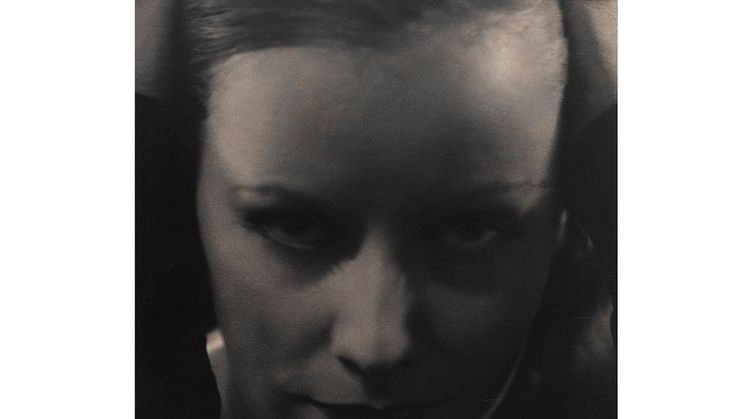
Press release -
New acquisition: Greta Garbo by Edward Steichen
Nationalmuseum has acquired a portrait of film legend Garbo, produced in 1928 by American photographer Edward Steichen. It was part of an entire series published in Vanity Fair. The portrait is an interesting example of contemporary avant-garde photography involving an extreme close-up.
Graham Greene wrote with great admiration about Garbo in film reviews in the 1930s. Roland Barthes analysed her face in the essay “Le Visage de Garbo”, published in Mythologies (1957). David Bowie sang “I’m the twisted name on Garbo’s eyes” in Quicksand on the album Hunky Dory (1971). The myth of Garbo is far greater than the sum of Greta Gustafsson’s (1905-1990) life and roles. More than seventy-five years after the premiere of her last film, she is still the most internationally renowned Swedish actress. Paradoxically, the photographic still image of the actress' face is more famous today than her role interpretations and films.
Most of the well-known pictures of Garbo are role portraits produced by still photographers who worked for her American film company Metro-Goldwyn-Mayer, e.g. Ruth Harriet Louise and Clarence Sinclair Bull. In addition to this, photos by Arnold Genthe, Edward Steichen and Cecil Beaton have also reached iconic status. Arnold Genthe took the first pictures of the then newly arrived actress for the US launch in Vanity Fair in 1925. The portrait was published under the heading A New Star from the North. In these early pictures, Garbo had not yet been styled to the persona later created for her in Hollywood. Cecil Beaton’s portrait, produced in 1946, shows Garbo with almost no makeup following the end of her career. She had then become one with the film industry's official image. Although she no longer starred in any new films, it was difficult to distinguish the person from the characters in her previous roles.
One of the films where Garbo played a femme fatale, elegant and seemingly spoiled but ultimately noble and self-sacrificing, was A Woman of Affairs. In connection with the 1928 production, Edward Steichen took a number of portraits for Vanity Fair. He was bothered by the curly haircut that Garbo's character Diana Merrick had in the film. The photographer wanted to show more of her famous face. The actress therefore used her hands to smooth and hold back her hair. From this session, there are both pictures of Garbo with unruly curly hair and stripped down portraits with her hair pulled back and her face in centre.
Nationalmuseum has now acquired one of Steichen’s portraits, thus filling a gap among the Garbo photographs already included in the National Portrait Gallery. This study is a close-up that gets closer to the Divine face than most in the Steichen series. In a charged close-up, the actress's intense gaze is directed towards the camera lens and thus indirectly at the observer. However, the idea of having the face framed by the hands was not entirely new. The year before, Ruth Harriet Louise used the same gesture when she photographed Garbo's role portrait for the now lost film The Divine Woman, directed by Swede Victor Sjöström. The gesture is also repeated later, including in Clarence Sinclair Bull's photo of Garbo in her first talking film Anna Christie (1929). Through this composition, the photographers placed the focus on Garbo's soulful eyes and her face's classically clean lines. Steichen’s version is still among the most famous portraits of Garbo.
Edward Steichen (1879-1973) had a long career as an influential American photographer. His debut around 1900 coincided with pictorialism, a movement that pushed for the acknowledgement of the art of photography. These photographers strived to depart from pure depiction and worked very consciously with composition and visual effects. During the period 1947-62, Steichen was also the director for the collection of photos at the Museum of Modern Art in New York. In this way he influenced both contemporary photography and the historiography in this area. The year before his retirement, the museum celebrated the 82-year-old photographer with a major retrospective, Steichen the Photographer. The now acquired Garbo portrait is a reprint that the artist produced particularly for this exhibition.
The acquisition of Edward Steichen’s portrait of Greta Garbo has been made possible through contributions from the Fritz Ottergren Fund, as well as donations by Ulla and Grunnar Trygg. Nationalmuseum has no funds of its own for acquiring art and applied artwork, but the collections are enriched through gifts, as well as contributions from foundations and funds.
Inventory number: NMGrh 5159
More information
Eva-Lena Karlsson, Curator, +46 8 519 544 30, eva-lena.karlsson@nationalmuseum.se
Mattias Robertson, Head of Press, +46 767 23 46 32, press@nationalmuseum.se
Related links
Categories
Nationalmuseum is Sweden’s museum of art and design. The collections comprise older paintings, sculpture, drawings and graphic art, and applied art and design up to the present day. The museum building is currently under renovation and scheduled to open again October 13, 2018. In the meantime, the museum will continue its activities through collaborations both in Sweden and abroad. Nationalmuseum has partnerships with Svenska Dagbladet and the Grand Hôtel Stockholm.

